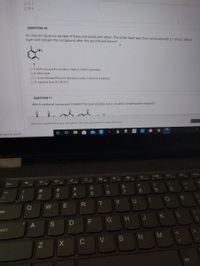
Chemistry
10th Edition
ISBN: 9781305957404
Author: Steven S. Zumdahl, Susan A. Zumdahl, Donald J. DeCoste
Publisher: Cengage Learning
expand_more
expand_more
format_list_bulleted
Question

Transcribed Image Text:OC1
O D.4
QUESTION 10
An impure aqueous sample of I was extracted with ether. The ether layer was then extracted with 0.1 M HCI. Which
layer will contain the compound after the second extraction?
NH2
O A. both, because I is soluble in both, 0.1 M HCl and ether.
O B. ether layer
O C. none, because I doesn't dissolve in ether in the first extraction.
O D. aqueous layer (0.1 M HCI)
QUESTION 11
Which carbonyl compound CANNOT form an enolate ion in an aldol condensation reaction?
Click Save and Submit to save and submit. Click Save All Answers to save all answers.
pe here to search
PriSc
F10
F11
F12
F7
F8
F9
Esc
F3
F4
F1
&
23
7
8
4
W
E
T
ab
G H J K
oSLk
C
VBN M
All
Co
Expert Solution
This question has been solved!
Explore an expertly crafted, step-by-step solution for a thorough understanding of key concepts.
Step by stepSolved in 2 steps with 1 images

Knowledge Booster
Learn more about
Need a deep-dive on the concept behind this application? Look no further. Learn more about this topic, chemistry and related others by exploring similar questions and additional content below.Similar questions
- Titration of another 30.0 mL sample of aqueous HX with 0.111M NaOH yields the titration curve below. A. Based on the titration curve and data provided, what is the molar concentration of HX? Does this agree with your earlier determination? B. What components in your flask account for the shape of the curve between 1 mL and 25 mL? Explain the shape in this region. C. The above titration curve is concave down from 0 mL to about 14 mL. Which of the components you listed in B is highest in concentration over this range? Consider how pH changes as you move backward from 14 mL back to 0 mL added base. How is this change consistent with the species you identified having a high concentration over this range? D. The above titration curve is concave up from 14 mL until the dramatic spike occurs. Which of the components you listed in B is highest in concentration over this range? How is the pH change from 14 mL to the upward spike consistent with this species having a high concentration over this…arrow_forwardThe pH at the half equivalence point volume (~15.3 mL) on the titration curve from this experiment is approximately 4.8. Based on this estimate, what value do you expect for the K₂ of CH3COOH? (Make sure you use the correct s.f. rule for logs where the number of decimals in the pH become the number of s.f. in the value.)arrow_forwardWrite the name or formula for a reagent that will dissolve PbC12 but not Hg2Cl2 and AgCl.arrow_forward
- Would the concentration of OH– in the solutions used for Runs 2–4 be different if deionized water was used to prepare them instead of aqueous NaCl solution? Explain.arrow_forward6.) Using the data in this graph: 12 What is the equivalence point? b. What is the half-way point of the titration? c. What is the pH at the half- way point? d. What is the pka? What is Ka for the acid Volume Base (mL) e. being used?arrow_forwardAsap solve itarrow_forward
arrow_back_ios
arrow_forward_ios
Recommended textbooks for you
 ChemistryChemistryISBN:9781305957404Author:Steven S. Zumdahl, Susan A. Zumdahl, Donald J. DeCostePublisher:Cengage Learning
ChemistryChemistryISBN:9781305957404Author:Steven S. Zumdahl, Susan A. Zumdahl, Donald J. DeCostePublisher:Cengage Learning ChemistryChemistryISBN:9781259911156Author:Raymond Chang Dr., Jason Overby ProfessorPublisher:McGraw-Hill Education
ChemistryChemistryISBN:9781259911156Author:Raymond Chang Dr., Jason Overby ProfessorPublisher:McGraw-Hill Education Principles of Instrumental AnalysisChemistryISBN:9781305577213Author:Douglas A. Skoog, F. James Holler, Stanley R. CrouchPublisher:Cengage Learning
Principles of Instrumental AnalysisChemistryISBN:9781305577213Author:Douglas A. Skoog, F. James Holler, Stanley R. CrouchPublisher:Cengage Learning Organic ChemistryChemistryISBN:9780078021558Author:Janice Gorzynski Smith Dr.Publisher:McGraw-Hill Education
Organic ChemistryChemistryISBN:9780078021558Author:Janice Gorzynski Smith Dr.Publisher:McGraw-Hill Education Chemistry: Principles and ReactionsChemistryISBN:9781305079373Author:William L. Masterton, Cecile N. HurleyPublisher:Cengage Learning
Chemistry: Principles and ReactionsChemistryISBN:9781305079373Author:William L. Masterton, Cecile N. HurleyPublisher:Cengage Learning Elementary Principles of Chemical Processes, Bind...ChemistryISBN:9781118431221Author:Richard M. Felder, Ronald W. Rousseau, Lisa G. BullardPublisher:WILEY
Elementary Principles of Chemical Processes, Bind...ChemistryISBN:9781118431221Author:Richard M. Felder, Ronald W. Rousseau, Lisa G. BullardPublisher:WILEY

Chemistry
Chemistry
ISBN:9781305957404
Author:Steven S. Zumdahl, Susan A. Zumdahl, Donald J. DeCoste
Publisher:Cengage Learning

Chemistry
Chemistry
ISBN:9781259911156
Author:Raymond Chang Dr., Jason Overby Professor
Publisher:McGraw-Hill Education

Principles of Instrumental Analysis
Chemistry
ISBN:9781305577213
Author:Douglas A. Skoog, F. James Holler, Stanley R. Crouch
Publisher:Cengage Learning

Organic Chemistry
Chemistry
ISBN:9780078021558
Author:Janice Gorzynski Smith Dr.
Publisher:McGraw-Hill Education

Chemistry: Principles and Reactions
Chemistry
ISBN:9781305079373
Author:William L. Masterton, Cecile N. Hurley
Publisher:Cengage Learning

Elementary Principles of Chemical Processes, Bind...
Chemistry
ISBN:9781118431221
Author:Richard M. Felder, Ronald W. Rousseau, Lisa G. Bullard
Publisher:WILEY